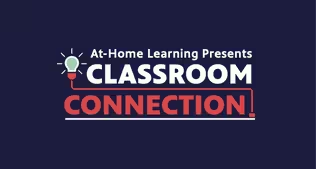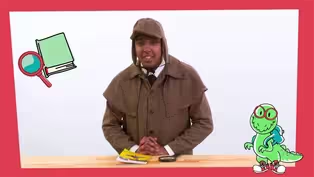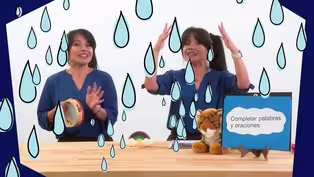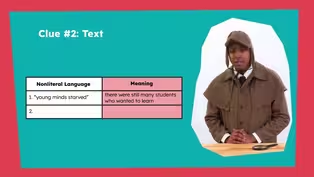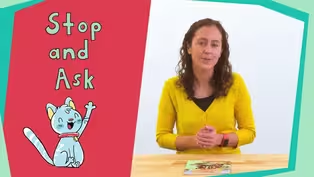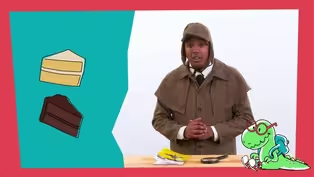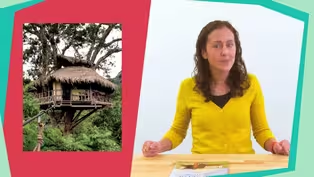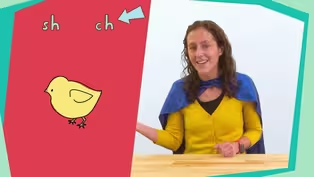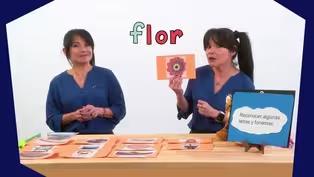
Episode 8 | Literacy Lessons
2/23/2021 | 28m 46sVideo has Closed Captions
Literacy lessons for early learners, led by NC teachers.
The first lesson is aimed at 3rd graders and explores multiple-meaning words in text. The second lesson (aimed at 1st-2nd graders) helps learners understand that letters make sounds and those sounds work together to make words. Classroom Connection is your At-Home Learning companion where children love to learn. All lessons are led by NC educators.
Problems playing video? | Closed Captioning Feedback
Problems playing video? | Closed Captioning Feedback
At-Home Learning Presents: Classroom Connection is a local public television program presented by PBS NC

Episode 8 | Literacy Lessons
2/23/2021 | 28m 46sVideo has Closed Captions
The first lesson is aimed at 3rd graders and explores multiple-meaning words in text. The second lesson (aimed at 1st-2nd graders) helps learners understand that letters make sounds and those sounds work together to make words. Classroom Connection is your At-Home Learning companion where children love to learn. All lessons are led by NC educators.
Problems playing video? | Closed Captioning Feedback
How to Watch At-Home Learning Presents: Classroom Connection
At-Home Learning Presents: Classroom Connection is available to stream on pbs.org and the free PBS App, available on iPhone, Apple TV, Android TV, Android smartphones, Amazon Fire TV, Amazon Fire Tablet, Roku, Samsung Smart TV, and Vizio.
Providing Support for PBS.org
Learn Moreabout PBS online sponsorshipMore from This Collection
Video has Closed Captions
Literacy lessons for early learners, led by NC teachers. (28m 46s)
Video has Closed Captions
Literacy lessons for early learners, led by NC teachers. (28m 46s)
Video has Closed Captions
Literacy lessons for early learners, led by NC teachers. (28m 45s)
Video has Closed Captions
Literacy lessons for early learners, led by NC teachers. (28m 45s)
Video has Closed Captions
Literacy lessons for early learners, led by NC teachers. (28m 46s)
Video has Closed Captions
Literacy lessons for early learners, led by NC teachers. (28m 46s)
Video has Closed Captions
Literacy lessons for early learners, led by NC teachers. (28m 45s)
Video has Closed Captions
Short Description: Literacy lessons for early learners, led by NC teachers. (28m 45s)
Video has Closed Captions
Literacy lessons for early learners, led by NC teachers. (28m 45s)
Video has Closed Captions
Literacy lessons for early learners, led by NC teachers. (28m 45s)
Video has Closed Captions
Literacy lessons for early learners, led by NC teachers. (28m 45s)
Video has Closed Captions
Literacy lessons for early learners, led by NC teachers. (28m 45s)
Providing Support for PBS.org
Learn Moreabout PBS online sponsorship[cheerful upbeat music] ♪ - Hi super learners, and welcome to my classroom.
I'm your host, Mr. R and I am so excited to hang with you today.
We're gonna have a really fun time together and we're gonna learn at the same time.
You ready?
[upbeat music] - Hello again, everyone.
My name is Ms. Shannon.
I'm so glad you're back with me to keep exploring this fantastic book called "Sun!
One in a Billion".
This book is unique because the author Stacy McAnulty, included elements of both informational and fiction to make it more interesting.
So in this book, we're learning facts about the sun in really fun ways.
Last time we learned several multiple meaning words and phrases, which are words that have more than one definition.
And we practiced using them correctly.
It's always great to learn new words so that when we hear or read them, we can understand what's going on.
We can also use them when we write or speak to others.
Oh look, here comes the sun to join us again.
Last time, we created this chart to help us see that some words and phrases have a literal and figurative meanings.
Let's use it to review the three multiple meaning words and phrases we discovered in the first part of the book.
We learned, star, hangout and revolve.
Remember that a star can be a literal ball of light and gas in outer space or figuratively, an entertainer, performer.
Hanging out can literally mean, something sticking out of something else, or it can figuratively mean spending time with the same people or in the same place.
Finally we learned, that revolve literally means to move in a circle around something.
And figuratively means, that something or someone is the most important.
Now that we've done a quick review of figurative and literal word meetings, let's continue our chart challenge with the rest of the book.
[air whooshing] Today, we're going to continue finding more multiple meaning words and phrases to add.
And this time, we're going to think more about how to determine what they mean.
Remember that some strategies we can use to determine word meetings include; using the words and pictures together, looking for antonyms and checking a dictionary.
Remember these strategies, so that when you're reading on your own, you can figure out word meanings in any text.
Are you ready to continue our chart challenge from last time?
Yes.
Let's get started word detectives.
Watch me read this page and add the next word to the chart to remind you how to find and understand multiple meaning words, then you can help me with the rest.
"But you can't fill me with Earths because I'm hot stuff.
Compare.
A hot summer day, 90 degrees Fahrenheit.
A pizza oven: 700 degrees Fahrenheit.
The orange-yellow flames in a campfire: about 2000 degrees Fahrenheit.
Me!
about 10,000 degrees Fahrenheit on the surface.
I can melt diamonds.
Me at my center, 27 million degrees Fahrenheit.
It says the sun is hot stuff.
This phrase has two meanings.
How can we figure out what they are?
The literal meaning is easier to find.
We can use the words and pictures together to see that the sun is much hotter than a summer day, a pizza oven and a fire.
So hot stuff literally means having an incredibly high temperature.
The figurative meaning is a little trickier to figure out.
But we can use the same strategy, using the words and pictures together to think it through.
If we consider the book as a whole, we've seen over and over again on many pages that the sun is very proud of itself and knows it's extremely important.
Like here, where it says directly that it is the most important.
And here, where it says it's outstandingly talented and popular.
This evidence helps us determine the figurative meaning of hot stuff.
Someone incredibly fabulous that others want to be around.
So, the sun is literally made out of hot stuff with a very high temperature that can burn you.
And, the sun is figurative hot stuff in this book because it's so loved, adored and celebrated.
We can confirm this by checking a dictionary.
When I look up hot stuff, it says, used to refer to a person or thing about standing quality, interest or talent.
So that matches what we figured out from the text by reading all around the word.
When's the last time you saw something that was literally hot stuff?
This morning, I had some coffee and that was definitely hot stuff.
Let's check in with our dogs, Spot and Muffin from last time.
Remember how Spot thinks that the world revolves around him?
That could also mean that he thinks that figuratively he's hot stuff.
How might Spot act since he thinks he's hot stuff?
Right, he might walk like this.
Now it's your turn word detectives, read this page with me.
And as we read, try to find a multiple meaning word.
"Not to hog the spotlight, but I've still got it.
I'm the same hot, bright star I've always been."
Did you find one?
I noticed the multiple meaning word, hog.
When you hear the word, hog, what do you think of?
I bet some of you thought of this.
Is that the literal or figurative meaning of hog?
Yes, that's the literal meaning of the word hog, a pig.
But it also has a figurative meaning and the author uses hog figuratively in her book.
Which strategy should we try to figure out its meaning?
Let's try to use the text and pictures together to figure it out.
I'm noticing that the sun is the only one on stage, so it's getting all the attention.
And it says it's hogging the spotlight.
No one else is in it.
So when you figuratively hog something, it means you're taking most or all of it and not leaving much for others.
Let's use a dictionary again to double check this.
When I look up hog, I see two definitions.
The first literal one says, a domesticated pig.
And the second figurative one says, keep or use all of something for oneself in an unfair or selfish way.
So, that matches what we figured out.
Look at there at Spot, he's hogging all the food.
Poor muffin.
Let's think of things we might want to hog or get a lot of.
Maybe our favorite foods or something else we really like.
I might want to hog the TV and watch only things that I want to, but I would need to be considerate and give others a turn.
Spot, quit hugging that food and give some to Muffin.
Good dog.
What's something you would probably not want to hog because it's something you don't like very much or it's not good to be around?
I would probably not hog someone's pet kitten even though kittens are cute because I'm allergic to cats, they make me sneeze.
Look word detectives, we've added two more words to our chart.
You're doing a great job with this challenge.
Now we found lots of multiple meaning words and phrases with figurative and literal meanings.
Let's keep going.
Read this page with me and look for the multiple meaning word.
"A stable star is a good star.
You don't want your Sun getting hotter or cooling off.
That would be really messy."
Did you find it?
Yes.
Stable has two meanings.
This one is a little different than the other multiple meaning words we found because it doesn't have a figurative and a literal meaning.
Instead, the two meanings of this word are just different parts of speech.
One is a noun, which is a person place or thing, and what is an adjective, which is a describing word.
We'll explore stable's two meanings more in just a minute.
But notice how this part of the chart is organized a little differently for multiple meaning words that can be used as different parts of speech.
So word detectives, which strategy should we try to figure out stable's meaning in this book?
Let's see if we can use antonyms.
It tells us stable is good because we don't want it getting hotter or cooler.
So that means we don't want it to change much.
From that, we can figure out that stable means not changing.
The sun's temperature is pretty stable because it doesn't get much hotter or colder.
So here, stable is an adjective because it's describing the Sun.
Something else I can think of that is stable or doesn't change much is the color of my eyes.
That's not really changing.
So my brown eye color is stable.
Since we've been thinking about antonyms, can you think of something that is unstable, meaning it changes a lot?
Something I thought of that's unstable, is the shape of a balloon when you're blowing it up.
It starts small, but it keeps changing by getting bigger.
That size was pretty unstable because it kept changing.
So now we know one meaning, but how can we figure out the other one?
I think we're gonna have to use the dictionary, since using the text will only teach us about the meaning we already found.
When I look up stable, it says the adjective meaning is, firmly fixed for the first definition that we already figured out.
So now we've double-checked that, which is great.
And for the second definition, it's a noun that means a building for animals, such as horses and cattle.
So the other thing that stable can mean, is a place where an animal lives.
What else might you expect to find in a stable along with a horse?
Yes.
Maybe some food, water, a brush for its tail or anything else that a horse might need.
Great job finding so many multiple meaning words for our chart word detectives.
You really rose to the challenge.
Okay.
Time for a review game to help us remember the multiple meaning words and phrases we learned today.
Is fire literal or figurative hot stuff?
Yes, fire is literal hot stuff because it's so hot it can burn you.
Figurative hot stuff is something that lots of people really like.
So something really cold like ice cream could actually be considered hot stuff if a ton of people love it.
Which kind of hog might you find in a stable?
This kind which is the animal, or this kind which is a person taking all the toys?
Yes, you'd find an animal in a stable.
And speaking of stable, which hog above is stable?
Yes, the hog that is still and not changing is stable and the one that keeps falling down is not stable because it's positioned keeps changing.
We did it word detectives, we found multiple meaning words in the book, placed them on our chart and used strategies to figure out what they mean.
Remember that some words and phrases can have both literal and figurative meanings.
Also remember, that some words can be different parts of speech which changes what they mean.
When you're reading, writing and listening to words, see how many multiple meaning words and phrases you can find.
Remember to use strategies like checking a dictionary, using the words and pictures together and looking for antonyms to figure out what words mean.
You can use these strategies with any book not just this one.
See you again soon.
[air whooshing] - I've been waiting for the perfect time to share this next video.
Check it out.
- The little red caboose was a staple on American freight trains until the 1970s.
Two crew members were stationed onboard this car to carry out two important duties.
From this cupola, I can keep an eye on the entire train and look for any problems.
One of the most common problems with the hotbox, which is one this axle bearings, runs out of oil and overheats.
This is the axle.
This brass piece, sits on top of the axle and holds the weight of the train.
As it spins, that needs to stay lubricated.
If it runs dry, it can get so hot, that the axle and this brass piece fuse together and the wheel stops spinning.
The worst case scenario, that can derail the train.
My other duty on this caboose is to protect my train from following traffic.
Now, before radio communication and automatic signals, trains were kept apart by a timetable that listed what time every train could be at each station.
As long you were on time, everything was fine.
If we were delayed and stopped in the middle of nowhere, another train following me would have no idea we were stopped, blocking their way.
Whenever we made an unscheduled stop, I would immediately grab my flagging kit and get off the train and start walking.
I'ma go a mile back.
When I got there, I put down two torpedoes on the engineer's side rail.
Torpedoes are small explosives, that when you run one over it explodes makes noise like a gunshot.
That tells the engineer of that train to slow down and watch for a flagmen.
They'll find that flagmen halfway between the torpedoes and this caboose, waving a red flag in the daytime or a red flare at night.
If we're traveling less than half the speed limit, I have to drop a lit flare off the back of the train every 10 minutes.
A train finding one of these burning by the side of the track, has to stop and wait for it to burn out, thus giving us enough time to stay ahead of them.
You won't find many cabooses out in the rails these days.
New sensors beside the track can spot many more problems than I could ever see from my cupola.
And now track side signals and radios have made dropping flares and waiving red flag a thing of the past.
- I just learned that a bolt of lightning is five times hotter than the sun.
Ooh!
It's hot.
How did I learn that?
Reading.
We're gonna get into our literacy lesson right now, so we can practice our reading.
Here we go.
- Hello readers.
My name is Ms. Gary, and I'm so excited to be learning with you today.
Before we get started with our lesson, let's say hello with our welcome song.
♪ Hello readers ♪ ♪ Hello readers ♪ ♪ How are you ♪ ♪ How are you ♪ ♪ I'm so glad to see you ♪ ♪ I'm so glad to teach you ♪ ♪ Hello you ♪ ♪ You and you ♪ Well readers, have you ever wondered how we know what sounds to say when we are reading words?
Hmm.
When I'm reading words or hearing words, how do I know what sounds the letters make or what sounds are in the word?
How do I know what letters are used to make those sounds?
We know what words are and what sounds letters make, because as a reader, our brains are using our knowledge of letter sounds to determine what sounds we hear in words.
This is what helps us read and write words.
For example, when I read the word bat, my brain tells me the word sounds like this, B-A-T, because the word bat is spelled B-A-T.
So before we can read words, we have to know what the sounds say.
So let's see and say the letter names and sounds of the letters on these cards together.
This is the letter b.
The letter b makes the sound b.
Can you say b?
Good readers.
Look at this letter.
This is the letter f. The letter F makes the sound ff.
Can you say ff?
Great job readers?
Do you know what this letter is?
That's right, this is the letter g. This makes the g-sound.
And sometimes it can make the sound j also.
This is the letter l the letter l makes the sound ll.
Can you say ll?
Great job.
Let's look at this letter.
This is the letter o.
This is a vowel, and it can say the sound oo or o.
Can you say that?
Here's our next letter.
This is the letter u.
This is a vowel that says the sound aah or u.
Here's our next letter.
This is the letter p. This makes the sound p. Can you say p like the letter p?
Great job.
And our last letter is the letter x.
The letter x makes the sound xx.
Can you say xx like the letter x?
Awesome work readers.
To keep practicing these letter sounds, you can make letter cards too.
Just ask your responsible adult to help you gather some index cards and write the letters and then practice saying the letter names and sounds with you.
You can also practice on your own too.
And this will help you get even better at knowing the letter sounds when you hear or read them.
In addition to knowing our letter sounds, during each lesson, we're going to learn some words.
These words have a special name, called heart words.
We call these words heart words, because we're practice reading them so that we'll know them by heart or so that we won't have to sound them out.
So let's look at this word.
This is the word, what.
Can you say, what?
Good.
Now let's spell it.
W-H-A-T. Say it one more time.
What.
Now, let's put this heart word in our minds and keep it there for when we see it in a book or write it on our paper.
Here comes our next one.
Look at this word.
This is the word, said.
Can you say said?
Now let's spell it.
S-A-I-D, said.
Let's say it one more time.
Good.
Now let's put this heart word in our mind and keep it there, so when we see it in a book or write it on paper.
So we've practiced to heart words, readers.
So we have one more to go today.
Let's look at this word.
This is the word, the.
Can you say, the?
Good.
The is spelled, T-H-E. Now, let's put this heart word in our mind also and keep it there for when we see it in a book or write it on paper.
Great heart word practicing readers.
Now let's move on to our focus for today.
In today's lesson, we're going to learn how to identify sounds we hear, in the beginning, middle and ends of words.
We're also going to break those sounds apart, and then blend them back together to read the word that we hear.
So let's get started.
I'm going to show you a picture and you're going to tell me what it.
What do you see?
That's right, it's a bug.
What letter sounds do you hear in the word bug?
Can you tell me the first or beginning sound in the word bug?
Yes it's b.
Can you say b, like in the beginning?
Now, what sound do you hear in the middle of bug?
Oh, I hear a u.
Say the u sound, in the word bug.
Now, can you tell me the last or final sound you hear in the word bug?
Right readers, I heard the g make the g sound in the word bug.
So let's say this word, bug.
Let's say the sounds we hear.
You ready?
B-U-G, bug.
Let's say it one more time.
Bug, that's the word bug.
I'm gonna take down the word bug and show you our next picture.
Look at this picture.
What do you see?
Yes readers, this is a plug.
Let's see what sounds we hear in the word plug.
The first sound we hear in the word plug, is p. That's right, it's the letter P and it makes the sound p. Can you say p?
Good.
What about the next sound in the word plug?
Yes, it's the l sound.
Good job.
What about the sound after?
Right.
It's the u, and it makes the sound uu.
Can you say uu?
And what's the last sound you hear in the word plug?
Great job.
It's the letter g and it makes the g sound.
So now let's blend those individual sounds together.
Are you ready?
P-L-U-G, plug.
Can you say it one more time?
Plug.
This is the word plug.
Now, I'm gonna show you another picture.
What do you see in this picture readers?
Good.
This is a Fox.
What's the beginning sound in the word fox?
Right, It's the ff sound.
Can you say ff like in fox?
Good.
That's the sound the letter f makes in fox.
What about our next sound?
Yeah, I heard you say O.
The letter O makes the oo sound.
What about our final sound in the word fox?
Right.
Our x makes the xx sound.
Can you make the xx sound like the letter x?
Great job.
So now, let's blend all of our sounds together and read our whole word, fox.
F-O-X, fox.
Great job.
Those sounds work together in this word to make the word fox.
Okay readers, let's get ready.
Now that we've practiced identifying letter sounds and blending them back together into words, I wanna teach you a strategy for practicing this skill on your own with new words.
So let's use our word, fox.
I can tap the sounds I hear in the word fox by using my fingers, F-O-X and blend them together, fox.
Can you try it on your own?
F-O-X, fox.
Great job.
So now we're gonna practice on our own.
What picture do you see here readers?
Can you tap out the sounds that you hear in the word box?
Great.
I heard you tap out the word box like this.
B-O-X, great job.
You tapped out the sounds, the word box.
B-O-X, box.
Now, look at this picture.
Can you tell me what this is?
It's a dog, but it's a special kind of dog.
This is a pug.
Can you tap out the sounds you hear in the word pug?
Let's hear.
Great job.
Did you tap out P-U-G, pug?
Good.
You tapped out the sounds in the word pug.
Well readers, that's the end of our lesson for today.
Thank you all for joining me as we learned about how to identify the sounds we hear in the words and blend those sounds together to read the word.
Remember to practice this skill when you're reading or writing your words.
I'll see you next time readers.
[air whooshing] - All right.
Everyone, our time has come to an end for today.
Another great day of learning under our belts.
Be cool, be courageous and be kind.
And don't forget, peace, love and learning.
Bye.
[cheerful upbeat music] ♪
Support for PBS provided by:
At-Home Learning Presents: Classroom Connection is a local public television program presented by PBS NC
